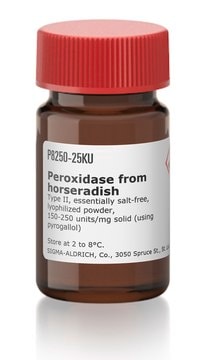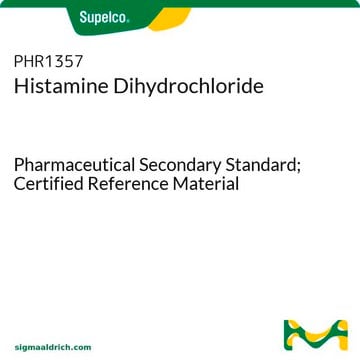D7876
Diamine Oxidase from porcine kidney
≥0.05 unit/mg solid
Synonym(s):
Amine:oxygen oxidoreductase (deaminating) (pyridoxal-containing)
Sign Into View Organizational & Contract Pricing
All Photos(4)
About This Item
Recommended Products
biological source
Porcine kidney
form
solid
specific activity
≥0.05 unit/mg solid
mol wt
170 kDa
solubility
100 mM sodium phosphate buffer, pH 7.2: soluble 10 mg/mL
foreign activity
monoamine oxidase (benzylamine substrate) ≤1%
storage temp.
−20°C
General description
Diamine oxidase from porcine kidney is a homodimer consisting of two equal subunits with a molecular weight of 87 kDa each. Each subunit contains one molecule of pyridoxal phosphate and one atom of copper. The molecular mass of the enzyme is found to be 170 kDa. The enzyme is a glycoprotein containing 5% hexose, 3.3% glucosamine, 2.6% N-acetylglucosamine, and 0.25% N-acetylneuraminic acid. The enzyme exhibits a high affinity for concanavalin A. Optimum pH with cadverine and histamine as substrates is found to be 6.3-7.4.
Application
Diamine Oxidase from porcine kidney has been used in the construction of histamine biosensor.
Diamine oxidase from porcine kidney has been used in a study to investigate a luminescence-based test for determining ornithine decarboxylase activity. Diamine oxidase from porcine kidney has also been used in a study to investigate N-linked oligosaccharide structures in diamine oxidase.
Biochem/physiol Actions
Diamine Oxidase catalyzes the oxidation of monoamines, diamines, and histamine to aldehydes, ammonia, and hydrogen peroxide. The enzyme is classified as a copper amine oxidase and it is a key enzyme in nitrogen metabolism. Diamine oxidase is inhibited by diethyldithiocarbamate, phenylhydrazine, semicarbazide, cyanide, isonicotinic acid hydrazide.
Unit Definition
One unit will oxidize 1.0 μmole of putrescine per hr at pH 7.2 at 37 °C.
Storage Class Code
11 - Combustible Solids
WGK
WGK 3
Flash Point(F)
Not applicable
Flash Point(C)
Not applicable
Personal Protective Equipment
dust mask type N95 (US), Eyeshields, Gloves
Certificates of Analysis (COA)
Search for Certificates of Analysis (COA) by entering the products Lot/Batch Number. Lot and Batch Numbers can be found on a product’s label following the words ‘Lot’ or ‘Batch’.
Already Own This Product?
Find documentation for the products that you have recently purchased in the Document Library.
Customers Also Viewed
Marta Moniente et al.
Food research international (Ottawa, Ont.), 160, 111735-111735 (2022-09-10)
Lentilactobacillus parabuchneri is the main bacteria responsible for the accumulation of histamine in cheese. The goal of this study was to assess the efficiency of potential histamine-degrading microbial strains or, alternatively, the action of the diamine oxidase (DAO) enzyme in
M A Shah et al.
The Biochemical journal, 253(1), 103-107 (1988-07-01)
Pig kidney diamine oxidase (DAO) was found to contain 5% (w/w) natural hexose, 3.25% glucosamine, 2.61% N-acetylglucosamine and 0.25% N-acetylneuraminic acid. The enzyme exhibited strong affinity towards concanavalin A (Con A) with a stoichiometry of 1:4.6. The kinetics of interaction
Diamine oxidase and catalase are expressed in the same cells but are present in different subcellular compartments in porcine kidney.
H G Schwelberger et al.
Inflammation research : official journal of the European Histamine Research Society ... [et al.], 48 Suppl 1, S81-S82 (1999-06-01)
A Rinaldi et al.
Preparative biochemistry, 12(1), 11-28 (1982-01-01)
Several methods for the isolation of apparently homogeneous pig kidney diamine oxidase have been reported in recent years (1-7), but these procedures allow to obtain only little amounts of material making very difficult the study of the molecular properties of
A PRELIMINARY INVESTIGATION ON A HISTAMINE BIOSENSOR CONSTRUCTED FROM DIAMINE OXIDASE IMMOBILISED ONTO AN OXYGEN PROBE
The Enzymes (1970)
Our team of scientists has experience in all areas of research including Life Science, Material Science, Chemical Synthesis, Chromatography, Analytical and many others.
Contact Technical Service











